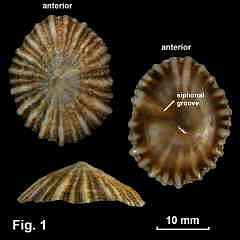|
|
SIPHONARIIDAE |
|
|
|
Siphonaria denticulata (Quoy & Gaimard, 1833) Description: Shell usually eroded; low to moderate in height, sides convex in large shells, straight or concave in small shells. Apex at or behind centre. Exterior sculptured with 15-30 strong primary ribs, which project at margin, with secondary and sometimes tertiary ribs between. Interior with horseshoe-shaped muscle scar and siphonal groove from apex to margin on right of shell, 70-80 degrees from anterior. Internal colour very variable, from mainly white to mainly dark brown; margin usually dark brown with white stripes corresponding to external primary ribs. Size: Up to 34 mm maximum diameter. Distribution: Endemic to Australia; Bowen Qld, southwards to Western Port Bay, Vic. Habitat: On rocks, over the whole intertidal range, on the open coast and in estuaries, almost up to the limit of tidal influence. Abundant. Comparison: Of the 4 large species of Siphonaria found in NSW:
Synonymy: This species was erroneously considered by Hubendick (1946) to be a synonym of Siphonaria diemenensis Quoy & Gaimard, 1833, and this error was carried forward into the Australian Faunal Directory. S. diemenensis and S. denticulata are distinct species. Remarks: Shape and sculpture vary widely in this species. Shells from exposed situations are low and those from sheltered positions relatively tall. The relative strength of the primary and secondary ribbing also varies widely, these being almost the same strength in some shells. The number of primary ribs is quite variable, but generally increases with the size of the shell. The life history and reproductive cycle has been investigated by Creese (1980, 1981). He found the life span to be 2-3 years, with occasional individuals surviving to 6 years. On settling, juveniles grow at about 4 mm per month, reaching maturity at a size of about 12 mm, but juvenile mortality is very high. Eggs are laid in a coiled, gelatinous egg ribbon, 30-60 mm long, easily seen attached to the rocky substrate among populations of the limpets. After about 6 days larvae are released from the egg ribbon and become planktotrophic. Fig. 1: Little Coogee Bay, Clovelly, Sydney, NSW. (C.343387). |
|
